#Custom WooCommerce E-Commerce Websites
Explore tagged Tumblr posts
Text
Custom WooCommerce & Shopify E-Commerce Website Design Services

When it comes to building a unique e-commerce presence, choosing the right platform and design services is essential. Custom WooCommerce E-Commerce Websites and Custom Shopify E-Commerce Website Design Services each offer distinct advantages, depending on your business needs. WooCommerce is a flexible, open-source platform designed for WordPress, making it ideal for those who want complete control over their store's features and customization options. It's an excellent choice for businesses that require detailed customizations and integrations.
On the other hand, Shopify is a fully hosted platform known for its simplicity, making it a great fit for businesses focused on ease of use and fast setup. With Custom Shopify E-Commerce Website Design Services, you can quickly build a professional, secure store with a variety of features and integrations.
Whether you choose WooCommerce or Shopify, custom design services from IWEBCODE allow you to create an online store that aligns with your brand, enhances customer experience, and drives conversions.
#web development services#web development services company#web development#web design and web development services#Custom WooCommerce E-Commerce Website Design Services#Custom Shopify E-Commerce Website Design Services#Custom WooCommerce E-Commerce Websites#Custom WordPress Website Design Services
0 notes
Text
The Evolution of PHP: Shaping the Web Development Landscape
In the dynamic world of web development, PHP has emerged as a true cornerstone, shaping the digital landscape over the years. As an open-source, server-side scripting language, PHP has played a pivotal role in enabling developers to create interactive and dynamic websites. Let's take a journey through time to explore how PHP has left an indelible mark on web development.
1. The Birth of PHP (1994)
PHP (Hypertext Preprocessor) came into being in 1994, thanks to Rasmus Lerdorf. Initially, it was a simple set of Common Gateway Interface (CGI) binaries used for tracking visits to his online resume. However, Lerdorf soon recognized its potential for web development, and PHP evolved into a full-fledged scripting language.
2. PHP's Role in the Dynamic Web (Late '90s to Early 2000s)
In the late '90s and early 2000s, PHP began to gain prominence due to its ability to generate dynamic web content. Unlike static HTML, PHP allowed developers to create web pages that could interact with databases, process forms, and provide personalized content to users. This shift towards dynamic websites revolutionized the web development landscape.
3. The Rise of PHP Frameworks (2000s)
As PHP continued to grow in popularity, developers sought ways to streamline and standardize their development processes. This led to the emergence of PHP frameworks like Laravel, Symfony, and CodeIgniter. These frameworks provided structured, reusable code and a wide range of pre-built functionalities, significantly accelerating the development of web applications.
4. PHP and Content Management Systems (CMS) (Early 2000s)
Content Management Systems, such as WordPress, Joomla, and Drupal, rely heavily on PHP. These systems allow users to create and manage websites with ease. PHP's flexibility and extensibility make it the backbone of numerous plugins, themes, and customization options for CMS platforms.
5. E-Commerce and PHP (2000s to Present)
PHP has played a pivotal role in the growth of e-commerce. Platforms like Magento, WooCommerce (built on top of WordPress), and OpenCart are powered by PHP. These platforms provide robust solutions for online retailers, allowing them to create and manage online stores efficiently.
6. PHP's Contribution to Server-Side Scripting (Throughout)
PHP is renowned for its server-side scripting capabilities. It allows web servers to process requests and deliver dynamic content to users' browsers. This server-side scripting is essential for applications that require user authentication, data processing, and real-time interactions.
7. PHP's Ongoing Evolution (Throughout)
PHP has not rested on its laurels. It continues to evolve with each new version, introducing enhanced features, better performance, and improved security. PHP 7, for instance, brought significant speed improvements and reduced memory consumption, making it more efficient and appealing to developers.
8. PHP in the Modern Web (Present)
Today, PHP remains a key player in the web development landscape. It is the foundation of countless websites, applications, and systems. From popular social media platforms to e-commerce giants, PHP continues to power a significant portion of the internet.
9. The PHP Community (Throughout)
One of PHP's strengths is its vibrant and active community. Developers worldwide contribute to its growth by creating libraries, extensions, and documentation. The PHP community fosters knowledge sharing, making it easier for developers to learn and improve their skills.
10. The Future of PHP (Ongoing)
As web technologies continue to evolve, PHP adapts to meet new challenges. Its role in serverless computing, microservices architecture, and cloud-native applications is steadily increasing. The future holds exciting possibilities for PHP in the ever-evolving web development landscape.
In conclusion, PHP's historical journey is interwoven with the evolution of web development itself. From its humble beginnings to its current status as a web development powerhouse, PHP has not only shaped but also continues to influence the internet as we know it. Its versatility, community support, and ongoing evolution ensure that PHP will remain a vital force in web development for years to come.
youtube
#PHP#WebDevelopment#WebDev#Programming#ServerSide#ScriptingLanguage#PHPFrameworks#CMS#ECommerce#WebApplications#PHPCommunity#OpenSource#Technology#Evolution#DigitalLandscape#WebTech#Coding#Youtube
30 notes
·
View notes
Text

Starting an e-commerce business can be an exciting venture with immense potential. However, with the opportunities come challenges and uncertainties. Before diving into the world of online retail, it’s crucial to plan carefully and set a solid foundation. Here are some essential tips to consider before launching your e-commerce business:
1. Conduct Market Research
Understanding the market is fundamental to any successful business. Start by identifying your target audience and analyzing competitors. Research trends, customer preferences, and potential gaps in the market. Tools like Google Trends, social media analytics, and industry reports can provide valuable insights. This research will help you tailor your products or services to meet market demands and differentiate yourself from competitors.
2. Define Your Business Model
E-commerce offers various business models, such as B2C (Business to Consumer), B2B (Business to Business), C2C (Consumer to Consumer), and subscription-based models. Determine which model aligns with your goals and resources. Each model has its own set of challenges and requirements, so choose one that best fits your product or service and target market.
3. Create a Solid Business Plan
A comprehensive business plan serves as a roadmap for your e-commerce venture. Outline your business goals, strategies, target audience, marketing plan, financial projections, and operational plan. This document will not only guide your efforts but also help secure funding if needed. A clear plan can keep you focused and organized as you navigate the complexities of launching and running an e-commerce business.
4. Choose the Right E-Commerce Platform
Selecting the right e-commerce platform is crucial for the success of your online store. Popular platforms like Shopify, WooCommerce, Magento, and BigCommerce each offer unique features and capabilities. Consider factors such as ease of use, scalability, customization options, payment gateways, and integration with other tools. The platform should align with your business needs and provide a user-friendly experience for both you and your customers.
5. Develop a User-Friendly Website
Your website is the face of your e-commerce business. Ensure it’s designed to be user-friendly, visually appealing, and optimized for mobile devices. A clean, intuitive layout with easy navigation will enhance the shopping experience and reduce cart abandonment rates. Focus on high-quality images, detailed product descriptions, and a seamless checkout process. Additionally, implement search engine optimization (SEO) strategies to improve your site’s visibility in search engines.
6. Implement Secure Payment Processing
Security is a top priority in e-commerce. Customers need to trust that their payment information is safe. Choose a reputable payment gateway and ensure your website uses SSL certificates to encrypt data. Additionally, offer multiple payment options, including credit/debit cards, digital wallets, and other payment methods that are popular with your target audience.
7. Plan Your Logistics and Supply Chain
Efficient logistics and supply chain management are vital for e-commerce success. Develop a strategy for inventory management, warehousing, and shipping. Decide whether you’ll handle fulfillment in-house or partner with third-party logistics providers. Consider shipping options, delivery times, and costs. A smooth and reliable fulfillment process can significantly impact customer satisfaction and repeat business.
8. Craft a Marketing Strategy
Effective marketing is essential to drive traffic and sales to your e-commerce store. Develop a multi-channel marketing strategy that includes social media, email marketing, content marketing, and paid advertising. Create engaging content, run promotions, and leverage social media platforms to build brand awareness and attract customers. Monitor and analyze the performance of your marketing efforts to refine your strategies over time.
9. Focus on Customer Service
Exceptional customer service can set your e-commerce business apart from competitors. Provide multiple channels for customer support, such as live chat, email, and phone. Ensure timely responses to inquiries and resolve issues promptly. Building strong customer relationships and encouraging feedback can enhance customer loyalty and drive positive reviews.
10. Monitor and Adapt
The e-commerce landscape is constantly evolving. Regularly review your business performance, track key metrics, and gather customer feedback. Stay informed about industry trends and technological advancements. Be prepared to adapt your strategies and operations based on insights and changes in the market.
#ecommerce#marketing#business#digitalmarketing#ecommercebusiness#entrepreneur#onlineshopping#website#seo#webdesign#b#marketingdigital#onlinebusiness#branding#shopify#smallbusiness#socialmediamarketing#webdevelopment#online#amazon#shopping#onlinestore#onlineshop#design#ecommercewebsite#dropshipping
5 notes
·
View notes
Text
Elevate Your Business with Expert E-commerce Website Development Services
E-commerce is no longer the future—it’s the present. With online shopping becoming second nature for millions worldwide, businesses must adapt to stay competitive. But creating a thriving e-commerce business takes more than uploading product images and adding a payment option. It demands a carefully crafted platform tailored to customer needs, brand identity, and technological advancements.
This is where an experienced e-commerce website development company like KSoft Technologies can help. We don’t just build websites; we craft experiences that turn casual browsers into loyal customers. In this blog, we’ll explore the importance of e-commerce websites, the role of a development company, and how partnering with KSoft Technologies can help your business thrive.
Why Every Business Needs an E-commerce Website
Let’s start with the basics. Why does your business need an e-commerce platform in the first place?
1. Reach a Global Audience
Your physical store may have geographical limitations, but an online store? The world is your marketplace. With a robust e-commerce website, you can reach customers across continents, breaking barriers like time zones and borders.
2. Operate 24/7
Unlike a traditional brick-and-mortar store, an e-commerce website doesn’t have operating hours. It’s open 24/7, allowing customers to shop anytime, from anywhere.
3. Cost-Effective Expansion
Expanding a physical store involves hefty expenses—rent, staff, utilities. An online store is a fraction of the cost and allows you to scale up without logistical hurdles.
4. Gain Valuable Insights
E-commerce websites are a treasure trove of data. From customer demographics to purchasing trends, analytics tools provide actionable insights to refine your marketing and sales strategies.
What Makes a Great E-commerce Website?
Creating a website is easy; creating an exceptional e-commerce website is not. Here are the must-have features that separate a mediocre website from a great one:
1. Intuitive Navigation
Shoppers shouldn’t need a map to find what they’re looking for. Clear menus, logical product categories, and search filters are non-negotiable.
2. High Performance and Speed
Studies show that a one-second delay in page load time can lead to a 7% drop in conversions. Speed matters, and we optimize every element of your site for peak performance.
3. Responsive E-commerce Website Design
More than half of online shopping happens on mobile devices. Our responsive e-commerce website design ensures your site looks and works beautifully across all devices.
4. Secure Payment Gateway Integration
From credit cards to digital wallets, customers expect secure and versatile payment options. We provide secure payment gateway integration for peace of mind.
5. Customizable Shopping Carts
The shopping cart is where conversions happen. Our customizable carts simplify adding items, applying coupons, and calculating taxes and shipping.
6. SEO-Friendly E-commerce Websites
Your website’s visibility on search engines directly impacts traffic and sales. We build SEO-friendly e-commerce websites with optimized code, meta tags, and fast loading speeds.
Why Work with KSoft Technologies?
Partnering with KSoft Technologies means working with a team that’s as passionate about your success as you are. Here’s what sets us apart:
1. Expertise Across Platforms
Whether you’re looking for Shopify development experts, WooCommerce website development, or Magento e-commerce solutions, we’ve got you covered. Our team has extensive experience with leading platforms.
2. Focus on Customization
Every business has unique needs, and we believe your website should reflect that. Our custom e-commerce solutions are tailored to your specific goals and industry requirements.
3. Scalability and Growth
Your e-commerce website should grow with your business. We build scalable platforms that adapt to increased traffic, product lines, and customer demands.
4. AI-Powered Personalization
We leverage AI to provide personalized shopping experiences, from tailored product recommendations to predictive search functionality.
5. Post-Launch Support
Our relationship doesn’t end at launch. We offer ongoing support and updates to keep your website running smoothly and securely.
Benefits of E-commerce Website Development
If you’re still wondering whether investing in an e-commerce website is worth it, let’s break down the benefits:
1. Increase Sales
A well-designed e-commerce platform makes it easier for customers to browse, buy, and return for more. From intuitive navigation to smooth checkout processes, every feature is geared toward boosting sales.
2. Lower Costs
Compared to traditional retail, an online store saves you money on overhead costs like rent, utilities, and staffing.
3. Build Brand Loyalty
By offering a seamless shopping experience, loyalty programs, and personalized recommendations, your website becomes a trusted destination for customers.
4. Expand Market Reach
With digital tools like social media integration and multi-vendor e-commerce platforms, you can reach more customers and explore new markets.
5. Gain Customer Insights
Analytics tools integrated into your website help you track customer behavior, identify trends, and make data-driven decisions.
Trends Shaping the Future of E-commerce
The e-commerce landscape is constantly evolving, and staying ahead means adopting emerging trends. Here’s what’s shaping the future:
1. Voice Commerce
With devices like Alexa and Google Home becoming household staples, voice search is transforming the way people shop. Optimizing your website for voice commerce ensures you stay relevant.
2. Augmented Reality (AR)
AR is revolutionizing online shopping by letting customers “try” products before they buy. From virtual fitting rooms to 3D product views, AR enhances the online shopping experience.
3. Blockchain Technology
Secure, transparent, and efficient—blockchain is changing the way payments and supply chains are managed in e-commerce.
4. Headless Commerce
This approach decouples the front-end and back-end of your website, giving you greater flexibility and faster load times.
5. Subscription-Based Models
From beauty boxes to meal kits, subscription models are gaining popularity. Adding a subscription option can create consistent revenue streams for your business.
Real-Life Success Stories: How KSoft Technologies Made a Difference
Case Study 1: A Fashion Retailer’s Makeover
A struggling fashion brand approached us with an outdated e-commerce platform that was driving customers away. We revamped their website with a responsive e-commerce design, faster loading times, and secure payment integration. The result? A 200% increase in sales within three months.
Case Study 2: Multi-Vendor Marketplace for Handmade Goods
An artisan collective needed a multi-vendor e-commerce platform to support their growing community of sellers. Our solution included customizable vendor dashboards, real-time inventory management, and integrated analytics. The platform became a go-to destination for handmade goods.
Case Study 3: Expanding a Local Grocery Store Online
A family-owned grocery store wanted to expand online but didn’t know where to start. We built an SEO-friendly website with advanced search filters, subscription options, and mobile optimization. Their monthly sales doubled within the first quarter.
2 notes
·
View notes
Text
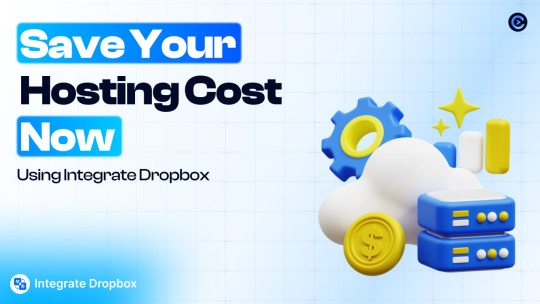
Work Smarter, Not Harder Use Dropbox As WordPress Hosting
Running a WordPress site often means juggling increasing hosting costs as your content grows. Many website owners find themselves paying premium prices for storage space, especially when their sites become media-heavy with images, videos, and documents.
Maximize Efficiency and Minimize Hosting Costs with Our Integrate Dropbox Plugin for WordPress
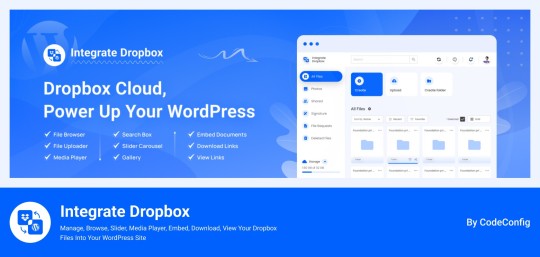
Integrate Dropbox best plugin for WordPress. Our Dropbox integration plugin reimagines how WordPress handles media storage. Instead of relying solely on your hosting server's storage, your media library seamlessly connects with Dropbox's robust infrastructure.
In the digital age, managing media files and optimizing website performance are top priorities for businesses and content creators. The balance between delivering rich media content and maintaining hosting efficiency can be challenging. That’s where Dropbox Integration Plugin comes in, providing a seamless bridge between Dropbox and WordPress to help you streamline file management, save on hosting costs, and enhance your user experience—all without coding hassles.
Why Hosting Optimization Matters
Every media file, video, or high-quality image hosted directly on your WordPress site consumes hosting resources. For companies scaling their content, this can quickly lead to higher hosting costs, slower load times, and potential website downtime. By integrating Dropbox with WordPress, CodeConfig’s plugin allows users to manage, display, and play Dropbox-hosted files directly on their site, significantly reducing the hosting load.
Integrate Dropbox Key Features To Solve Real Problems
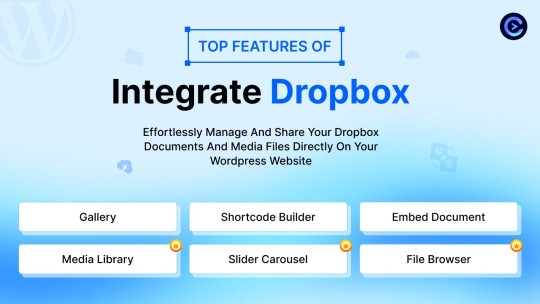
Our plugin is packed with features designed to make Dropbox integration simple, secure, and efficient:
Media Library Integration Directly access Dropbox files from your WordPress Media Library. Upload files, use high-quality images for featured posts, and seamlessly add media to your content without overloading your hosting.
Elementor and Gutenberg Integration Designed to work with popular page builders, our plugin offers 7 customizable blocks for Gutenberg and over 7 Elementor widgets. Effortlessly add Dropbox-hosted media, galleries, sliders, and file browsers to your pages without coding.
WooCommerce Compatibility For e-commerce sites, our plugin provides a unique solution for downloadable products. Upload product files to Dropbox and offer them as downloadable products in WooCommerce. This ensures smooth delivery and saves precious server space.
Dynamic File Browser, Gallery, and Media Player Add Dropbox files as interactive elements, such as galleries or media players, directly into your content. This feature is ideal for course creators and content-heavy websites. Our Slider Carousel and Media Player are customizable to fit your brand’s aesthetic, offering both style and function.
Shortcode Builder and Custom Embeds With our intuitive Shortcode Builder, users can quickly generate and customize modules like media players, sliders, and file browsers. Embed files, set view-only permissions, and create download links—all with simple shortcodes. This means less reliance on heavy plugins and more control over your content display.
Saving Costs Without Sacrificing Quality
Using CodeConfig’s Dropbox Integration Plugin not only reduces hosting expenses but also delivers a faster, more reliable user experience. By offloading storage to Dropbox, your website can handle more traffic and richer content without performance dips.
Our responsive design ensures that these features look great on both desktop and mobile, providing a seamless experience across devices.
Lightning-Fast Media Management
WordPress users can now upload media directly through the familiar WordPress interface while the plugin automatically syncs it to Dropbox. No need to learn new tools or change your workflow - everything happens behind the scenes.
Enhanced Website Performance
By offloading media storage to Dropbox, your WordPress site becomes significantly lighter and faster. Your server resources focus on running core WordPress functions rather than handling heavy media requests.
2 notes
·
View notes
Text
The Best Free WordPress Plugins You Should Use

If you're running a WordPress website, plugins are essential for adding functionality, improving performance, and optimizing the user experience. At Island Wizards, a company dedicated to providing WordPress headless and Shopify services, we understand the importance of selecting the right plugins for your website. To help you get started, we've compiled a list of the best free WordPress plugins that you should consider for your site.
1. Yoast SEO
Yoast SEO is one of the most popular and comprehensive SEO plugins available. It helps you optimize your content for search engines by providing keyword analysis, readability scores, and detailed SEO suggestions.
Key Features:
Real-time page analysis
XML sitemap generation
On-page optimization for readability and keywords
This plugin ensures that your content is SEO-friendly, which can boost your site's visibility in search engine results pages (SERPs).
2. WPForms
Every website needs a reliable contact form, and WPForms is one of the easiest form builders out there. With its drag-and-drop functionality, you can create beautiful forms in minutes, even if you're not tech-savvy.
Key Features:
Drag-and-drop builder
Mobile responsive
Spam protection
WPForms makes it simple for your visitors to get in touch with you, making it a must-have for businesses like Island Wizards.
3. Elementor
For those looking to design stunning web pages without coding, Elementor is the go-to plugin. This free page builder offers a user-friendly interface that allows you to create custom layouts and designs.
Key Features:
Drag-and-drop editor
100+ templates
Mobile-friendly designs
At Island Wizards, we recommend Elementor for clients who want full control over their website's appearance without relying on custom coding.
4. WooCommerce
If you're running an online store, WooCommerce is the ultimate plugin for e-commerce. It powers more than 30% of all online stores, and it's fully customizable, allowing you to sell anything from physical products to digital downloads.
Key Features:
Built-in payment processing
Inventory management
Customizable product pages
As experts in WordPress and Shopify, we at Island Wizards often integrate WooCommerce for clients looking to build a robust online store.
5. UpdraftPlus
Backing up your website is crucial, and UpdraftPlus simplifies this process. This backup plugin allows you to store your backups in the cloud or download them for safekeeping.
Key Features:
Scheduled backups
Cloud storage integration
Easy restoration
At Island Wizards, we always advise our clients to have a backup strategy, and UpdraftPlus is the perfect solution for that.
6. Smush
Website speed is critical for user experience and SEO, and Smush helps by compressing your images without sacrificing quality. This image optimization plugin reduces file sizes, making your site faster and more efficient.
Key Features:
Lossless image compression
Bulk image optimization
Lazy loading
Faster websites tend to rank higher in search engines, and at Island Wizards, we prioritize performance for all our clients.
7. Wordfence Security
Security is a top priority for any website, and Wordfence provides a comprehensive security plugin to protect your site from malicious attacks.
Key Features:
Firewall and malware scanner
Login security
Real-time threat defense feed
With security being a major concern, we at Island Wizards strongly recommend Wordfence to all our WordPress clients.
Conclusion
Whether you're just starting out with your WordPress site or looking to enhance its functionality, these free plugins are essential tools for success. At Island Wizards, we specialize in WordPress development and can help you integrate these plugins into your site seamlessly. Choosing the right plugins can significantly improve your site's performance, security, and overall user experience, ensuring your website operates at its full potential. Explore more about our service… https://islandwizards.com/blogs/when-you-should-consider-moving-your-store-to-shopify/ https://islandwizards.com/blogs/understanding-the-importance-of-ui-ux-in-website-design/
#shopify#headless wordpress development services#island wizards#wordpress#island wizards uk'#shopify partner program#wizards island#seo#white label agency
2 notes
·
View notes
Text
ClickAISites: Your Gateway to Effortless Online Selling

Powerful Features:
Create an Affiliate Store in 1 Click:
Build your ecom affiliate store on autopilot. Simply select the products from your desired niche, and let the software handle the rest.
Breathtaking Affiliate Sites:
Choose from over 50 complementary themes to create stunning, customizable e-commerce sites that attract massive traffic.
1-Click Import of Top-Selling Products:
Add high-demand products from Amazon with a single click. Access millions of products across thousands of niches.
Sell High-Quality Videos, Trainings, and More:
Beyond products, sell auto-generated trainings, videos, PLR products, and more to boost your conversions.
Automated Store Operations:
Automatically insert product names, generate content and images, update prices, and insert affiliate links. Manage multiple sites from a single dashboard.
WooCommerce Integration:
Seamlessly integrate with WooCommerce for efficient payments and smooth commission earnings.
Automated Product Management:
AI manages your products, variants, shipping, and coupons effortlessly.
Auto-Generated Blogs and Custom Pages:
Engage your audience and boost SEO with informative blog posts and custom pages created by our built-in AI.
SEO Optimization:
Improve your site’s ranking with meta keywords and descriptions to rank higher in search engines.
Mobile-Friendly Sites:
Ensure your affiliate sites are responsive and accessible from any device.
No Domain & Hosting Required:
We handle hosting and maintenance, with no monthly hosting fees or ongoing costs.
No Coding or Technical Expertise Needed:
Our AI develops websites with ease, so you don’t need to be a coder or hire one.
Start Your Own Agency:
With our unlimited commercial license, you can start a profitable agency and enjoy unprecedented profits.
100% Newbie Friendly:
Designed for beginners, anyone can use our platform.
Step-by-Step Training Included:
Access easy video tutorials and training materials to guide you through the process.
Cloud-Based Software:
Access your site from anywhere in the world on any device with a browser. No installation or updates needed.
30 Day Money Back Guarantee:
If we can’t solve your technical problems with ClickAiSite, just send us a message, and we’ll refund every penny. No questions asked.
>>>Get More Info
2 notes
·
View notes
Text
7 Best Dropbox Plugins for WordPress
Dropbox is one of the most common free cloud storage offerings. Dropbox is a secure place to store your WordPress backups, media, and documents. Your files are safe and accessible from any device or location. It also improves your website’s performance, functionality, and safety.
Using a Dropbox plugin for WordPress saves hosting space and manages files in the cloud. As your website grows, so do your media files, documents, and digital assets. This increase requires more management. Dropbox integration offers a simple, efficient solution that enhances your website experience.
Why Use Dropbox In WordPress
Dropbox WordPress Plugin boosts your site’s storage without changing hosting. It also enhances security. Dropbox offers better protection than traditional computers. It includes encryption, secure transfers, and audits.
Storing files on Dropbox eases the server’s load. This improves loading times and free up resources for quicker page downloads.
Popular plugins For Dropbox Integrations with WordPress
Integrate Dropbox
Updraft Plus
WP Media Folder
Out-of-the-Box
WooCommerce Dropbox
Dropr
Zapier
Top Reasons to Choose Integrate Dropbox over competitors
Conclusion
Integrate Dropbox
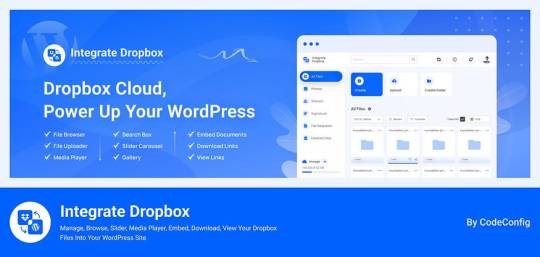
Integrate Dropbox offer smooth integration between Dropbox and WordPress with the most user-friendly Dropbox plugin from WordPress Dashboard. Easily Manage your media files and save hosting space without coding hassles. This plugin has several benefits. It allows users to access Dropbox files in the WordPress Media Library. They can also upload and download files directly from the dashboard. These files automatically sync with their Dropbox account.
Additionally, users can search for Dropbox files and folders in the dashboard. They can create shortcodes for display on the front end. This includes live search and thumbnail previews.
Price: Free for the base plugin, This plugin has Premium Plan
Features Of Integrate Dropbox
⚙️ Easy Setup — Effortlessly Setup! With this plugin, just add the Dropbox App and Secret Key from your Dropbox account to authorize Dropbox Account and WordPress integration. Documentation
🔎 Search Module — Search your Dropbox Files and Folders by name and use them in your shortcode, featured images, or different pages and posts.
🗂️ Upload/Create files & folders — Upload or Create Files and Folder in Dropbox files from your WordPress dashboard
👷♀️ Shortcode Builder — Shortcode Builder lets users easily create and customize modules. These include a Media Player, Slider, File Browsers, Galleries, and Download & Embed links. Users can insert the generated shortcode anywhere on their WordPress site.
🌆 Gallery — Gallery allows you to create a gallery to display images and videos interactively. Showcase your content beautifully and engage your audience with a visually appealing presentation.
🛠️ Shortcode Module — Shortcode Module allows you to easily select and insert built-in shortcodes from a dropdown menu, streamlining the process of adding custom features to your website.
📄 Embed Documents — Embed your Dropbox documents directly into your WordPress website.
🔗 Download Links — Allow your e-commerce, Digital Product customers to download media and document files.
👁️ View Links — Protect your important files by allowing customers to only view them without downloading them.
🛟 Preloader — Choose from our selection of predefined preloaders to enhance your website’s loading experience.
🌈 Customize Backend Colors- Easily customize the colors of your website’s backend using our predefined options.
📱 Responsive Design- The plugin makes your File Browser, Gallery, Upload Box, and Media Player look great on desktop and mobile. It provides a seamless user experience.
UpdraftPlus

UpdraftPlus is a top WordPress plugin for easy backups and restores. It allows users to store backups in Dropbox safely. The plugin excels in features. Notably, it offers automated backup schedules for easy recovery. It also supports incremental backups, saving only changes since the last full backup. This approach cuts down on space and resource use. Moreover, UpdraftPlus encrypts backups before sending them to Dropbox, ensuring added security.
Price: Free for the base plugin, This plugin has Premium Plan
WP Media Folder
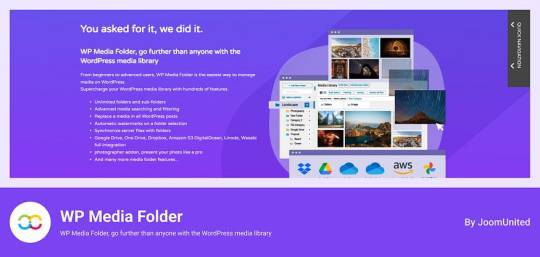
WP Media Folder connects your WordPress media library to Dropbox for easy management. You can organize Dropbox media directly from WordPress. The interface is similar to desktop applications, making it simple to use. Changes made in one platform appear in the other instantly. It also allows you to create galleries from Dropbox images, improving your website’s media handling.
Price: The plugin offers a Premium Plan.
Out-of-the-Box

Out of the Box is a WordPress plugin that integrates Dropbox files. It brings your Dropbox info to the WordPress dashboard. You can easily drag and drop content. This is especially useful for projects with multiple users needing frequent updates. The plugin keeps files in sync, ensuring a smooth experience across both platforms.
Price: This plugin has Premium Plan
WooCommerce Dropbox
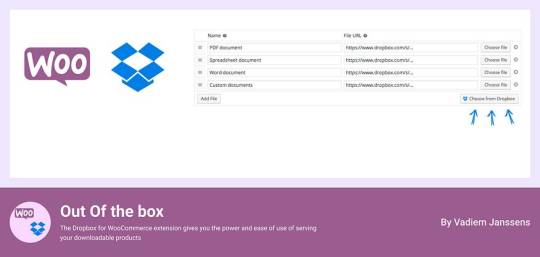
WooCommerce Dropbox lets store owners link their digital products to Dropbox files. It enhances WooCommerce and ensures timely delivery of digital products. This setup is especially helpful for selling digital items like software, music, or videos.
Shoppers get fast and simple downloads without slowing the website down. Using less server effort helps the site stay strong when many people visit. The WooCommerce Dropbox plugin improves downloadable products. It allows store owners to use Dropbox for their files. This saves server space and speeds up downloads for customers.
Price: Free for the base plugin
Dropr

Dropr links Dropbox to your WordPress site easily. It sets Dropbox as the main storage for media files. Thus, all uploads go directly to Dropbox, saving server space. Moreover, Dropr lets you share Dropbox files in your WordPress media library and embed them in posts. Uploading images, videos, or documents with Dropr is as simple as using local files.
This setup is perfect for sites with lots of posts and resources. It ensures constant updates and supports various media. Dropr speeds up file transfers. This way, you keep your site fresh and active.
Price: Free for the base plugin, This plugin has Premium Plan
Zapier

Zapier links with WordPress and Dropbox to automate tasks. Though not standard plugins, they create complex workflows, enhancing efficiency and collaboration. For example, you can automatically post on WordPress when new files are added to Dropbox. This feature is especially beneficial for teams that need an updated and efficient online dashboard.
Price: Free for the base plugin, This plugin has Premium Plan
Top Reasons to Choose Integrate Dropbox over competitors
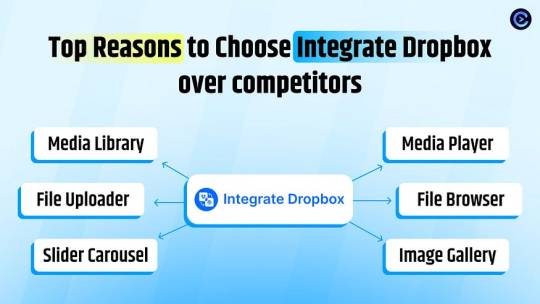
Integrate Dropbox plugin is free for WordPress and links your site to Dropbox easily. It’s perfect for organizing files. Site owners with often updated content find it especially helpful. They can manage everything from one place. This prevents issues with file syncing and access, all through the WordPress dashboard.
File Browser offers easy access to Dropbox files from any device upload on WordPress media library. Meanwhile, the Media Player lets users play Dropbox media on their WordPress site with a customizable player. By upgrading to premium, users can create unlimited shortcodes to integrate content anywhere on their site. This feature works well with popular themes.
These features collectively enhance usability, integration, and media management, making the “Integrate Dropbox” plugin a strong choice for WordPress users.
🧩 RICH INTEGRATION WITH POPULAR PLUGINS
▶️ Media Library Integration Simply use your Dropbox files from WordPress Media library and add the images in pages and posts as media, featured images, galleries, etc. Get the Image from Dropbox directly.
🔀 Gutenberg Block Editor Integration Integrate Dropbox allows 7 blocks for using File Browser, Gallery, Media Player, Slider, View, and Download link modules in the Gutenberg editor.
🔀 Elementor Website Builder Integration This plugin integrates with Elementor, offering over 7 widgets for File Browser, Gallery, Media Player, Slider, View, and Download link modules.
Conclusion
Integration of Dropbox on WordPress has turned into a necessary technique for current website scenario.
Connecting Dropbox to WordPress is now essential for managing websites. It improves file organization, backups, and collaboration. Plugins like “Integrate Dropbox” and “WP Media Folder” help site admins and developers. They can work faster and manage digital media better.
The right Dropbox WordPress plugin can greatly improve website management. It saves space and boosts performance. Additionally, it helps users create a more efficient online setup. This secures content and allows easy sharing across platforms.
4 notes
·
View notes
Text
RedotPay: The Ultimate Payment Gateway for Fiat and Crypto Transactions.

Introduction
In today’s fast-paced digital economy, having a reliable payment gateway is crucial for businesses. RedotPay offers a versatile solution for managing both fiat and cryptocurrency transactions, making it an ideal choice for modern businesses. With features like zero tax transactions, free virtual cards, and global ATM access, RedotPay simplifies online payments while enhancing security and convenience. Plus, enjoy a $5 sign-up bonus and easy transferability. Discover why RedotPay is the preferred choice for businesses and how you can benefit from their referral program.
What is RedotPay?

RedotPay is an advanced payment gateway designed to handle both traditional fiat currencies and a range of cryptocurrencies. It provides a user-friendly platform that supports seamless online payments, ensuring high security and adaptability for businesses of all sizes. Key features include zero tax transactions, free virtual cards, and global ATM support.
Key Features of RedotPay
1. Support for Fiat and Cryptocurrency:
RedotPay supports transactions in both traditional currencies and digital cryptocurrencies. This feature allows businesses to cater to a diverse customer base and stay ahead in the evolving financial landscape.
2. Easy 0% Tax Transactions:
Enjoy effortless transactions with RedotPay’s zero tax processing. This feature eliminates additional transaction costs, simplifying financial management and maximizing your profits.
3. Free Virtual Card:
Upon signing up, you receive a free virtual card from RedotPay. This card can be used for secure online purchases, subscriptions, and other transactions, offering an extra layer of security.
4. Support for All Major E-Commerce Platforms:
RedotPay integrates seamlessly with all major e-commerce platforms such as Shopify, WooCommerce, and Magento. Whether you’re running an online store on Shopify or selling products on AliExpress, RedotPay ensures smooth and efficient payment processing.
5. Global ATM Access:
Access your funds from anywhere in the world with RedotPay’s support for local and international ATMs. There are no restrictions on where you can withdraw your money, offering unmatched convenience.
Why Choose RedotPay?
RedotPay is a powerful payment gateway that combines flexibility, security, and ease of use. By supporting both fiat and cryptocurrencies and offering features like free virtual cards and global ATM access, RedotPay addresses the needs of today’s global marketplace. With zero tax transactions and a $5 sign-up bonus, it’s a compelling choice for businesses looking to optimize their payment processing.
How to Benefit from RedotPay's Referral Program
RedotPay’s referral program provides an opportunity to earn commissions by introducing new clients to the platform. Here’s how you can start:
1. Sign Up:
Register for the RedotPay referral program on their website and receive a unique referral link.
2. Promote RedotPay:
Share your referral link via your website, blog, or social media. Highlight RedotPay’s key features and benefits, such as its integration with platforms like Shopify and AliExpress, to attract potential clients.
3. Earn Commissions:
For every new client who signs up using your referral link, you’ll earn a commission. The more referrals you generate, the greater your earnings.
4.Track Your Progress:
Use RedotPay’s dashboard to monitor your referrals and commissions. This allows you to stay updated on your performance and refine your promotional strategies.
Conclusion
RedotPay offers a versatile and secure payment gateway solution that accommodates both fiat and cryptocurrency transactions. With features such as zero tax transactions, a free virtual card, global ATM access, and seamless integration with major e-commerce platforms like Shopify and AliExpress, RedotPay provides exceptional value. Don’t miss the opportunity to earn a $5 sign-up bonus and commissions through the referral program. Sign up for RedotPay today and experience top-tier payment processing.
Call to Action
Ready to enhance your payment processing? Join RedotPay now to enjoy a $5 sign-up bonus and start earning through our referral program. Get started today and revolutionize your payment experience!
#crypto#bitcoin#virtual card buy with cryptocurrency#signupbonus#free earning#cryptocurrency#ecommerce#shopify#aliexpress#affiliate program
2 notes
·
View notes
Text
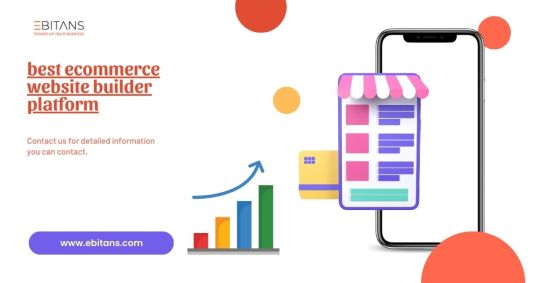
Finding the Best E-Commerce Website Builder for Your Business
Choosing the right e-commerce website builder is crucial for creating a successful online store. With numerous options available, selecting the best platform can significantly impact your business’s growth and efficiency. Here’s a guide to help you find the best e-commerce website builder that suits your needs.
1. Ease of Use
The best e-commerce website builders should offer an intuitive interface that simplifies the process of setting up and managing your store. Look for platforms with user-friendly drag-and-drop editors and customizable templates. These features make it easier to create a professional-looking website without requiring advanced technical skills.
2. Essential Features
Evaluate the core features each builder offers. Key functionalities include product management, secure payment processing, inventory tracking, and shipping options. Advanced features such as SEO tools, marketing integrations, and analytics capabilities can further enhance your online store’s performance.
3. Design Flexibility
A visually appealing and unique online store helps attract and retain customers. Choose a builder that provides a range of customizable templates and design options. This allows you to tailor your site’s appearance to align with your brand’s identity and create a memorable shopping experience.
4. Scalability
As your business grows, your e-commerce platform should be able to scale with you. Opt for a builder that offers flexible plans and additional features to accommodate increased traffic, a larger product range, and expanded functionalities. Scalability ensures your website remains effective and efficient as your business evolves.
5. Support and Resources
Reliable customer support and comprehensive resources are essential for troubleshooting and ongoing management. Select a builder that provides responsive support through various channels, such as live chat, email, or phone. Additionally, access to tutorials, guides, and community forums can be valuable for resolving issues and learning best practices.
Top Recommendations
Shopify: Known for its ease of use and robust feature set, Shopify is ideal for businesses of all sizes. It offers a wide range of customizable templates, integrated payment options, and excellent customer support.
WooCommerce: Perfect for those familiar with WordPress, WooCommerce provides extensive customization and flexibility. It’s suitable for businesses with specific needs and technical capabilities.
BigCommerce: Renowned for its scalability, BigCommerce is a great choice for growing businesses. It offers built-in features for SEO, multi-channel selling, and advanced analytics.
Wix: Wix combines simplicity with design flexibility. Its drag-and-drop editor and diverse templates make creating a visually appealing online store easy.
Squarespace: With its elegant design templates and user-friendly interface, Squarespace is perfect for businesses seeking a stylish and functional online store with minimal effort.
READ MORE >>>>
2 notes
·
View notes
Text
How to Sell Your Products Online
In the digital age, selling your products online is not just an option but a necessity for business success. The internet provides a vast marketplace, but standing out and making sales requires a strategic approach. Here’s a comprehensive guide to help you sell your products online effectively and attractively.
1. Define Your Target Audience
Understanding your target audience is crucial. Who are they? What are their preferences and pain points? Conduct market research to identify their demographics, interests, and buying behavior. This insight will shape your marketing strategy and product presentation, ensuring you connect with the right customers.
2. Choose the Right E-Commerce Platform
Selecting the right e-commerce platform is essential for your online sales success. Consider popular options like Shopify, WooCommerce, and BigCommerce. Look for features that match your business needs, such as customizable templates, payment gateways, and inventory management. A user-friendly interface and reliable customer support are also critical.
3. Create a Compelling Online Store
Your online store is your digital storefront, so make it visually appealing and user-friendly. Invest in a professional design that reflects your brand’s identity. High-quality product images, clear descriptions, and easy navigation will enhance the shopping experience and encourage purchases. Ensure your store is mobile-friendly, as many customers shop on their smartphones.
4. Optimize Product Listings
Effective product listings are key to attracting and converting buyers. Write clear, engaging product descriptions that highlight the benefits and features of your products. Use persuasive language and incorporate keywords that potential customers might use in their search queries. High-resolution images from multiple angles, along with videos if possible, can help customers make informed decisions.
5. Leverage Social Media Marketing
Social media platforms are powerful tools for reaching and engaging with your audience. Create and share content that resonates with your target market, including product showcases, behind-the-scenes looks, and customer testimonials. Use targeted ads to reach specific demographics and drive traffic to your online store. Platforms like Instagram, Facebook, and Pinterest can be particularly effective for visual products.
6. Implement SEO Strategies
Search Engine Optimization (SEO) helps improve your store’s visibility on search engines like Google. Optimize your website by using relevant keywords, creating high-quality content, and ensuring fast loading times. Implement on-page SEO techniques, such as meta tags and alt text for images, and build backlinks to boost your site’s authority and ranking.
7. Offer Excellent Customer Service
Providing exceptional customer service can set you apart from competitors and foster loyalty. Respond promptly to customer inquiries, offer multiple contact options, and provide clear information about shipping, returns, and exchanges. Positive reviews and testimonials can enhance your credibility and attract more buyers.
8. Utilize Email Marketing
Email marketing is a powerful tool for nurturing leads and driving sales. Build an email list by offering incentives like discounts or exclusive content. Send personalized emails to your subscribers, including product recommendations, promotions, and updates. Automated email campaigns can help you stay connected with your audience and encourage repeat purchases.
9. Monitor and Analyze Performance
Regularly monitor your online store’s performance using analytics tools. Track metrics such as website traffic, conversion rates, and average order value to gauge the effectiveness of your strategies. Analyze customer behavior to identify trends and areas for improvement. Use this data to make informed decisions and optimize your sales approach.
10. Adapt and Innovate
The online marketplace is constantly evolving, so staying adaptable is crucial. Keep an eye on industry trends, emerging technologies, and changing consumer preferences. Experiment with new marketing tactics, update your product offerings, and continually refine your strategies to stay competitive and meet your customers’ needs.
By following these steps, you’ll be well-equipped to successfully sell your products online. Focus on understanding your audience, optimizing your store, and delivering exceptional service to create a compelling and profitable online presence. Embrace the digital landscape, and watch your business thrive in the online marketplace.
2 notes
·
View notes
Text
E-commerce Website Hosting and Management Solutions
With the rise of online shopping and the increasing importance of having a strong online presence, e-commerce websites have become essential for businesses of all sizes. However, building and managing an e-commerce website can be a complex task that requires specialized knowledge and resources. This is where e-commerce website hosting and management solutions come into play, providing businesses with the necessary tools and infrastructure to establish and maintain a successful online store.

Choosing the Right E-commerce Hosting Provider
The first step in setting up an e-commerce website is selecting a reliable hosting provider. A good hosting provider ensures that your website is accessible to visitors, provides fast loading times, and ensures the security of customer data. Here are some factors to consider when choosing an e-commerce hosting provider:
1. Scalability and Performance
Your e-commerce website needs to handle increasing traffic and accommodate growth over time. Look for hosting providers that offer scalable solutions and can handle high volumes of traffic without compromising performance. This ensures that your website remains fast and responsive even during peak shopping seasons or promotional events.
2. Security Measures
Security is crucial for any e-commerce website, as it deals with sensitive customer information such as credit card details. Ensure that the hosting provider offers robust security measures such as SSL certificates, regular backups, and advanced firewalls to protect against cyber threats and data breaches.
3. E-commerce Platform Support
Check if the hosting provider supports the e-commerce platform you intend to use. Popular platforms like Magento, Shopify, WooCommerce, and BigCommerce have specific hosting requirements. Ensure that the provider offers specialized hosting solutions optimized for your chosen platform, as this can significantly enhance the performance and reliability of your website.
4. Customer Support
E-commerce websites need prompt technical support, especially during critical periods. Look for hosting providers that offer 24/7 customer support through various channels like live chat, email, or phone. Responsive customer support can help resolve any issues quickly and minimize downtime, ensuring smooth operations for your online store.
E-commerce Website Management Solutions
Once you have selected a hosting provider, you also need effective website management tools to run your e-commerce store efficiently. Here are some essential features and solutions to consider:
1. Content Management System (CMS)
A robust CMS is essential for managing the content on your e-commerce website. It should allow you to easily update product information, create engaging landing pages, and optimize your website for search engines. Popular CMS options for e-commerce include WordPress, Drupal, and Joomla, each with their own strengths and capabilities.
2. Inventory Management
Efficient inventory management is crucial for e-commerce success. Look for website management solutions that provide inventory tracking, automated stock alerts, and integration with your e-commerce platform. These features help you keep track of stock levels, avoid overselling, and streamline order fulfillment processes.
3. Payment Gateway Integration
Ensure that your website management solution supports integration with popular payment gateways such as PayPal, Stripe, or Authorize.net. Seamless payment processing is vital for providing a smooth customer experience and encouraging online sales.
4. Analytics and Reporting
Tracking and analyzing key metrics is essential for optimizing your e-commerce website’s performance. Look for management solutions that provide detailed analytics and reporting capabilities, allowing you to monitor traffic, conversion rates, customer behavior, and other important insights. This data helps you
make informed decisions to improve your website and drive sales.
5. Mobile Responsiveness
With the increasing use of mobile devices for online shopping, it is crucial to have a mobile-responsive e-commerce website. Your website management solution should offer responsive design templates or customization options to ensure that your online store looks and functions seamlessly across different devices and screen sizes.
Conclusion
E-commerce website hosting and management solutions play a vital role in the success of online businesses. By carefully selecting a reliable hosting provider and implementing effective website management tools, businesses can create a secure, scalable, and high-performing e-commerce store. These solutions empower businesses to focus on their core competencies while leaving the technical aspects of running an online store to the experts, ultimately leading to improved customer experiences, increased sales, and long-term growth.

source
#WebManagement#ServerHosting#WebsiteMaintenance#TechSupport#CloudHosting#DataCenter#ServerManagement#WebHosting#ITInfrastructure#WebsiteSecurity#ServerAdmin#HostingSolutions#WebsitePerformance#ServerMonitoring#WebDevelopment#CloudComputing#NetworkSecurity#DomainRegistration#BackupandRecovery#Cybersecurity
18 notes
·
View notes
Text

Comparing Laravel And WordPress: Which Platform Reigns Supreme For Your Projects? - Sohojware
Choosing the right platform for your web project can be a daunting task. Two popular options, Laravel and WordPress, cater to distinct needs and offer unique advantages. This in-depth comparison by Sohojware, a leading web development company, will help you decipher which platform reigns supreme for your specific project requirements.
Understanding Laravel
Laravel is a powerful, open-source PHP web framework designed for the rapid development of complex web applications. It enforces a clean and modular architecture, promoting code reusability and maintainability. Laravel offers a rich ecosystem of pre-built functionalities and tools, enabling developers to streamline the development process.
Here's what makes Laravel stand out:
MVC Architecture: Laravel adheres to the Model-View-Controller (MVC) architectural pattern, fostering a well-organized and scalable project structure.
Object-Oriented Programming: By leveraging object-oriented programming (OOP) principles, Laravel promotes code clarity and maintainability.
Built-in Features: Laravel boasts a plethora of built-in features like authentication, authorization, caching, routing, and more, expediting the development process.
Artisan CLI: Artisan, Laravel's powerful command-line interface (CLI), streamlines repetitive tasks like code generation, database migrations, and unit testing.
Security: Laravel prioritizes security by incorporating features like CSRF protection and secure password hashing, safeguarding your web applications.
However, Laravel's complexity might pose a challenge for beginners due to its steeper learning curve compared to WordPress.
Understanding WordPress
WordPress is a free and open-source content management system (CMS) dominating the web. It empowers users with a user-friendly interface and a vast library of plugins and themes, making it ideal for creating websites and blogs without extensive coding knowledge.
Here's why WordPress is a popular choice:
Ease of Use: WordPress boasts an intuitive interface, allowing users to create and manage content effortlessly, even with minimal technical expertise.
Flexibility: A vast repository of themes and plugins extends WordPress's functionality, enabling customization to suit diverse website needs.
SEO Friendliness: WordPress is inherently SEO-friendly, incorporating features that enhance your website's ranking.
Large Community: WordPress enjoys a massive and active community, providing abundant resources, tutorials, and support.
While user-friendly, WordPress might struggle to handle complex functionalities or highly customized web applications.
Choosing Between Laravel and WordPress
The optimal platform hinges on your project's specific requirements. Here's a breakdown to guide your decision:
Laravel is Ideal For:
Complex web applications require a high degree of customization.
Projects demanding powerful security features.
Applications with a large user base or intricate data structures.
Websites require a high level of performance and scalability.
WordPress is Ideal For:
Simple websites and blogs.
Projects with a primary focus on content management.
E-commerce stores with basic product management needs (using WooCommerce plugin).
Websites requiring frequent content updates by non-technical users.
Sohojware, a well-versed web development company in the USA, can assist you in making an informed decision. Our team of Laravel and WordPress experts will assess your project's needs and recommend the most suitable platform to ensure your web project's success.
In conclusion, both Laravel and WordPress are powerful platforms, each catering to distinct project needs. By understanding their strengths and limitations, you can make an informed decision that empowers your web project's success. Sohojware, a leading web development company in the USA, possesses the expertise to guide you through the selection process and deliver exceptional results, regardless of the platform you choose. Let's leverage our experience to bring your web vision to life.
FAQs about Laravel and WordPress Development by Sohojware
1. Which platform is more cost-effective, Laravel or WordPress?
While WordPress itself is free, ongoing maintenance and customization might require development expertise. Laravel projects typically involve developer costs, but these can be offset by the long-term benefits of a custom-built, scalable application. Sohojware can provide cost-effective solutions for both Laravel and WordPress development.
2. Does Sohojware offer support after project completion?
Sohojware offers comprehensive post-development support for both Laravel and WordPress projects. Our maintenance and support plans ensure your website's continued functionality, security, and performance.
3. Can I migrate my existing website from one platform to another?
Website migration is feasible, but the complexity depends on the website's size and architecture. Sohojware's experienced developers can assess the migration feasibility and execute the process seamlessly.
4. How can Sohojware help me with Laravel or WordPress development?
Sohojware offers a comprehensive range of Laravel and WordPress development services, encompassing custom development, theme and plugin creation, integration with third-party applications, and ongoing maintenance.
5. Where can I find more information about Sohojware's Laravel and WordPress development services?
You can find more information about Sohojware's Laravel and WordPress development services by visiting our website at https://sohojware.com/ or contacting our sales team directly. We'd happily discuss your project requirements and recommend the most suitable platform to achieve your goals.
3 notes
·
View notes
Text
Unveiling Excellence: Selecting the Best WooCommerce Website Design and Development Company
In the dynamic landscape of e-commerce, establishing a strong online presence is essential for businesses to succeed. WooCommerce, with its flexibility and scalability, has emerged as a popular choice for building online stores within WordPress websites. However, choosing the right WooCommerce website design and development company is crucial for achieving optimal results. In this article, we'll explore the key considerations when selecting a WooCommerce website design and development company.
Expertise and Experience in WooCommerce Development: Begin your search by evaluating the expertise and experience of the WooCommerce website design and development company. Look for a team with a proven track record of working with WooCommerce, WordPress, and related technologies. Their experience will ensure that your online store is built efficiently, customized to your needs, and optimized for performance.
Customization Capabilities: Your e-commerce website should reflect your brand identity and unique selling proposition. Choose a company that offers extensive customization capabilities within the WooCommerce framework. They should be able to tailor your website to align with your brand aesthetics, preferences, and business goals, creating a memorable and cohesive shopping experience for your customers.
Responsive Design Expertise: With the increasing prevalence of mobile shopping, having a responsive website is essential. Ensure that the WooCommerce website design and development company specializes in creating designs that adapt seamlessly to various screen sizes and devices. A mobile-friendly website not only enhances user experience but also improves your site's search engine rankings.
E-Commerce and Conversion Optimization Focus: Building a successful online store goes beyond aesthetics; it needs to drive conversions and generate sales. Look for a company that specializes in e-commerce design and conversion optimization techniques. They should focus on elements such as intuitive navigation, persuasive product presentations, clear call-to-action buttons, and streamlined checkout processes to maximize conversion rates.
SEO Integration and Digital Marketing Support: An effective e-commerce website needs to attract traffic and visibility to succeed. Choose a WooCommerce website design and development company that understands the importance of search engine optimization (SEO) and integrates digital marketing strategies into their design process. From optimizing product pages to implementing metadata and structured data, SEO-friendly features should be integral to the design and development of your online store.
Comprehensive Support and Training: Launching and managing an online store can be complex, so ensure that the WooCommerce website design and development company offers comprehensive support and training services. They should provide assistance with setup, configuration, and ongoing maintenance, as well as training resources to empower you to manage your store effectively.
Portfolio and Client Testimonials: Evaluate the company's portfolio to assess the quality and diversity of their WooCommerce website designs. Look for examples that showcase their expertise in e-commerce design and development. Additionally, read client testimonials and reviews to gain insights into their professionalism, communication, and ability to deliver results.
In conclusion, selecting the best WooCommerce website design and development company is a critical step in ensuring the success of your online store. By considering factors such as expertise in WooCommerce development, customization capabilities, responsive design expertise, e-commerce and conversion optimization, SEO integration, support and training, and client testimonials, you can make an informed decision that sets your online store up for success. Entrust your WooCommerce website to a partner that not only creates visually stunning designs but also prioritizes functionality, usability, and conversion-driven strategies to help your e-commerce business thrive.
2 notes
·
View notes
Text
A Comprehensive Guide to Developing Custom E-Commerce Websites in 2024

In the dynamic landscape of web commerce development, building a custom e-commerce website has become essential for businesses seeking to establish a strong online presence and drive sales. As we navigate through 2024, the demand for unique, user-friendly, and feature-rich e-commerce platforms continues to grow. In this comprehensive guide, we'll explore the key steps and considerations involved in developing custom e-commerce websites, with insights from Xettle Technologies, a leading provider of innovative web commerce solutions.
Define Your Objectives and Requirements: The first step in developing a custom e-commerce website is to define your objectives and requirements. Consider factors such as your target audience, product range, business goals, and budget. Are you looking to create a sleek and modern storefront, or do you require advanced features such as inventory management, order tracking, and customer accounts? By clearly outlining your needs, you can ensure that your e-commerce website is tailored to meet your specific requirements.
Choose the Right E-commerce Platform: Selecting the right e-commerce platform is crucial for the success of your online store. Evaluate the features, scalability, customization options, and pricing of different platforms to find the one that best suits your needs. Popular options include WooCommerce, Shopify, Magento, and BigCommerce, each offering unique advantages depending on your business size and requirements. Xettle Technologies offers expertise in various e-commerce platforms and can assist you in selecting the ideal solution for your business.
Design a User-Centric Interface: The design of your e-commerce website plays a significant role in attracting and retaining customers. Aim for a clean, intuitive, and mobile-responsive interface that enhances the user experience. Incorporate high-quality images, clear navigation menus, and prominent calls-to-action to guide visitors through the purchasing process. Consider usability testing and feedback from real users to refine your design and optimize conversion rates. Xettle Technologies specializes in creating user-centric e-commerce interfaces that captivate audiences and drive engagement.
Implement Secure Payment Gateways: Security is paramount in e-commerce transactions to instill trust and protect sensitive customer information. Integrate secure payment gateways that comply with industry standards and encryption protocols, such as SSL/TLS encryption and PCI DSS compliance. Offer a variety of payment options, including credit cards, digital wallets, and alternative payment methods, to accommodate customer preferences. Xettle Technologies provides robust payment gateway integration services, ensuring seamless and secure transactions for your e-commerce website.
Optimize for Search Engines: To maximize visibility and drive organic traffic to your e-commerce website, it's essential to optimize it for search engines. Conduct keyword research, optimize product descriptions and metadata, and implement on-page SEO best practices to improve your website's ranking in search engine results pages (SERPs). Additionally, consider implementing structured data markup to enhance the visibility of your products in search engine listings. Xettle Technologies offers SEO services tailored to e-commerce websites, helping you achieve higher search engine rankings and attract qualified traffic.
Enable Analytics and Tracking: Track and analyze user behavior, sales performance, and website metrics to gain valuable insights into your e-commerce operations. Implement analytics tools such as Google Analytics or Adobe Analytics to monitor website traffic, conversion rates, and customer engagement. Utilize this data to identify opportunities for optimization, refine your marketing strategies, and enhance the overall performance of your e-commerce website. Xettle Technologies integrates advanced analytics and tracking capabilities into custom e-commerce websites, empowering businesses to make informed decisions and drive growth.
Ensure Scalability and Flexibility: As your business grows, your e-commerce website should be able to scale and adapt to accommodate increasing traffic and evolving requirements. Choose a flexible and scalable architecture that can support future growth and expansion. Regularly update and maintain your website to ensure optimal performance, security, and compatibility with emerging technologies. Xettle Technologies offers scalable web commerce development solutions that grow with your business and adapt to changing market dynamics.
In conclusion, developing a custom e-commerce website requires careful planning, strategic execution, and ongoing optimization. By defining your objectives, choosing the right platform, designing a user-centric interface, implementing secure payment gateways, optimizing for search engines, enabling analytics and tracking, and ensuring scalability and flexibility, you can create a successful online store that drives sales and enhances customer satisfaction. Partnering with a trusted provider like Xettle Technologies can help you navigate the complexities of web commerce development and achieve your e-commerce goals in 2024 and beyond.
2 notes
·
View notes
Text
Pre-Launch Strategies for Your Festive WooCommerce Store
The festive season is approaching, and if you're planning to launch a brand new WooCommerce store, now is the perfect time to prepare for a successful start. Building anticipation and creating a buzz around your store before the official launch can help you hit the ground running. Let's dive into some pre-launch strategies that will set the stage for a smooth festive eCommerce workflow.
1. Craft a Memorable Brand Identity: Your brand and business should align seamlessly. Choose a color scheme that complements your brand, and focus on creating a unique and memorable experience for your customers. Tools like Elementor can simplify the process of customizing your product pages, allowing you to design them exactly as you envision.
2. Verify Your Store's Functionality: Before launching, thoroughly check your store's functionality. Ensure that everything, from product listings to payment processing, is working smoothly. A flawless shopping experience is crucial.
3. Build Anticipation with Announcements: Make some noise about your brand! Utilize all available platforms to spread the word about your products and brand values. Create 'COMING SOON' pages on social media, complete with countdown timers. Use your blog to provide sneak peeks of your product line and generate excitement.
4. Create Lead-Generating Landing Pages: Landing pages are an excellent way to establish your brand's presence. Craft unique landing pages with customer-friendly and SEO-friendly content. Don't forget to analyze your competitors' strategies for inspiration.
5. Craft Compelling Product Descriptions: Enhance your product pages with product add-ons. Add fields like text boxes, checkboxes, and dropdowns, and include variations with sample images. This level of detail can make a significant impact on your product listings.
6. Optimize Speed and Responsiveness: Consult WooCommerce experts to evaluate your store's speed, responsiveness, and overall performance. Ensure that your website is optimized for quick loading and displays beautifully on various devices.
7. Quality Assurance Testing: Thoroughly test all website features, functionalities, and design layouts. Identify and address any bugs or technical issues to ensure a seamless shopping experience.
8. Beta Version Testing: Before the official launch, release a beta version of your e-commerce website. This phase helps evaluate the success of earlier testing and gather user feedback in real-world scenarios.
9. Content Marketing: Provide relevant content related to your products or services before your launch. Address the problems your products solve and the solutions you offer through your brand. Use blog posts, tutorials, webinars, eBooks, and other content forms to engage your audience.
10. Analytics Tools: Equip your WooCommerce store with essential analytics tools like Lighthouse, Search Console, SEMRush, and Google Analytics. These tools will help you track and improve your website's performance and conversion rate.
By implementing these pre-launch strategies, you'll set the foundation for a successful festive season for your WooCommerce store. Building excitement and anticipation among your audience can lead to a memorable launch and a strong start in the competitive world of e-commerce.
3 notes
·
View notes